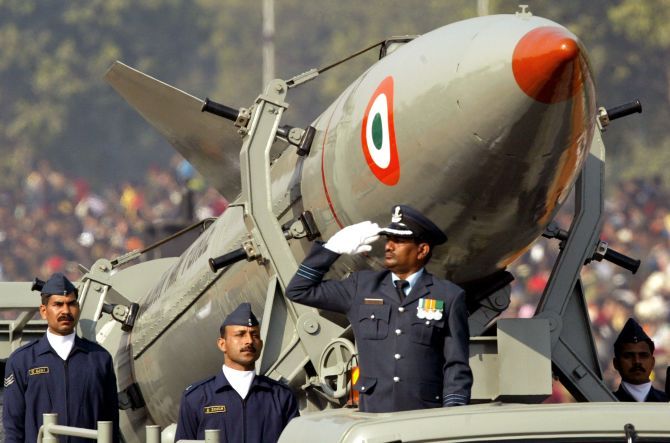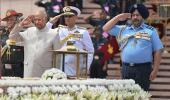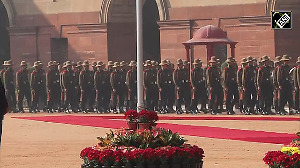'While we have to hiss loudly and do the lunging bit to keep our foes on their toes, that’s only a tactical matter. What is the strategic goal? What is the end game?
'In my opinion, there is only one possible end game: the unwinding of Pakistan into several pieces: Balochistan, Sind, Balawaristan (Gilgit, Baltistan, the rest of PoK), the Pashtun area Khyber Pakhtunwa which will merge with Afghanistan, and the rump Punjab,' says Rajeev Srinivasan.

On August 15, Prime Minister Narendra Modi announced the creation of the office of the Chief of Defence Staff. On August 16, Defence Minister Rajnath Singh made a statement in Pokhran that India was prepared to revisit its traditional ‘No First Use’ policy for nuclear weapons, should circumstances warrant. These two actions have implications: India will no longer hesitate to use deadly force.
Of course, this is in the background of the repeal of Articles 370/35A and the bifurcation of the erstwhile state of Jammu and Kashmir into two Union territories. This was, almost certainly, announced earlier than scheduled to pre-empt the geopolitical fallout on India from the imminent surrender by Americans to the Taliban in Afghanistan, and thus the capture of ‘strategic depth’ -- their long-term dream -- by the Pakistani Army and ISI.
There is every chance that Pakistan will ratchet up terrorist attacks on Jammu and Kashmir once the clampdown of Section 144 is lifted, as it will be in the coming weeks. In addition, there is the chance that Pakistani sleeper cells all over India will be activated. In the immediate aftermath of the BJP’s thumping win on May 23, there were suddenly small-scale riots all over India; and they were ratcheted down equally mysteriously, in a couple of weeks: it was a proof of concept of the ability of the sleeper cells to deliver.
What Rajnath Singh was signalling was that if there were sufficient grounds for India (for example, a major terrorist strike or a repeat of Godhra 2002), it would no longer abide by its Gandhian self-abnegation, but impose heavy costs on Pakistan, including a nuclear first strike.
Incidentally, it was a signal also to Pakistan’s all-weather friend China, which has shepherded through an unofficial UN Security Council meeting to air their case, that India is serious.
There is the Panchatantra story of the cobra and the monk. The cobra terrorised village people with its venom and fierceness; then it met a monk, and on his advice, transformed itself into a peace-loving creature, and gave up biting people.
Then it found itself the butt of cruel jokes by the local kids, who were no longer afraid, and would taunt and torture it, injuring it.
The cobra complained to the monk that its vow of peacefulness had meant it was being bullied, prodded and stoned by the youngsters. Whereupon the monk told it: “You only promised me that you wouldn’t bite; I never asked you not to hiss fearsomely and lunge at people as though you would bite”.
In other words, a little marketing never hurt anybody.
India is doing a little hissing, but it can also do a little biting, and everybody knows that.
While nobody wants a war, India is attempting to pre-empt the possibility with a little diplomatic theatre. In fact, there is a sort of “domino-theory” type activity going on, with several players acting out threats and counter-threats, all jockeying for power, and one domino can have a serious impact on another.
For, there is a long game being played. US President Trump is focused on his re-election campaign for November 2020, and would like to present Americans with a nice little talking-point: that he has brought the troops home after 19 years of a fruitless and brutal war. Trump is also indulging in a trade war with the Chinese.
There is more. Trump appears to be actively following the Chinese concept of total war, which includes trade, money flows, cyber attacks, space, quantum weapons, in fact, anything and everything.
The idea goes back to two senior Chinese colonels, Qiao Liang and Wang Xiangsui, who published Unrestricted Warfare: Assumptions on War and Tactics in the Age of Globalization in February 1999. Here is a quote:
‘Unrestricted Warfare’ means that any methods can be prepared for use, information is everywhere, the battlefield is everywhere, and that any technology might be combined with any other technology, and that the boundaries between war and non-war and between military and non-military affairs has systematically broken down.
Of course this works both ways. There is nothing that prevents the US from returning the favour, and that is precisely what the US is doing. Tariffs are just one part of it. Cutting off scientific contact with China is part of it. Ejecting Chinese researchers is, too. Targeting Huawei and attempting to cripple it is also part of the plan.
And the ‘troubles’ in Hong Kong are part of ‘unrestricted warfare’ being applied to China. It is evident that China has no good choices there: brutal bloodshed would kill the goose that laid the golden egg, in that it would produce an exodus of talented people who would move to Singapore or other cities.
On the other hand, if President Xi Jinping does nothing in Hong Kong, he would ‘lose face’ and give confidence to other restive areas such as Xinjiang and Tibet.
If you look at it closely, the Hong Kong troubles have a definite undercurrent of religion: it is the Christian church that is leading the protests. Let us remember another area where the church prevailed over the ruling junta: eastern Europe, in particular the ex-Soviet Union. It is well known that an alliance between the Catholic church and certain three-letter acronym spy agencies led to the sudden collapse of the Soviet Union.
That is because the church is used as an arm of foreign policy by various nations, and certainly by the US. There is another interesting case from India: the vimochanasamaram (liberation movement) that brought down the EMS Namboodiripad government in Kerala in 1959 (it was the very first elected communist government anywhere in the world). The church and lay Christians (along with some others) were able to overturn a democratically elected government (in those days of the original Domino Theory, Americans were very allergic to communists).
Thus the eastern front has been opened against China. What if a western front is also opened against China? That is the threat they face. For, if there were military action, and India were to send armoured columns into Pakistani-Occupied Kashmir, it would have repercussions for the famous Belt and Road Initiative (BRI).
The China Pakistan Economic Corridor (CPEC) is the crown jewel of BRI and runs through PoK, which is occupied Indian territory. At one point, the CPEC, which is an extension of the Karakoram Highway, is less than 100 miles from the Line of Control. An armoured thrust by India (no, I am not assuming the Pakistanis would roll over and play dead) cutting CPEC is a scenario that would not appeal at all to China.
There is certainly this veiled threat to China in the defence minister’s statement about No First Use.
Would the Americans like this Second Front opened against the Chinese? Quite likely because it would embarrass them. Trump would certainly be willing to push India into war to advance his own interests. This could well be the reason for the US’s reluctance to bully India over 370.
I am not saying that the Chinese will roll over and play dead, either. An Indian armoured thrust that cuts the CPEC will certainly invite punitive Chinese actions, quite possibly in Ladakh.
So it would be best not to drive them into a position where they have to declare war on India. Something short of that, which causes them serious loss of face, would be good.
A two-front war would be tough for India, and anyway jaw-jaw is better than war-war, as that old racist Churchill once said.
But the point is that we have to hiss loudly and do the lunging bit to keep our foes on their toes.
Yet that’s only a tactical matter. What is the strategic goal? What is the end game? I asked this question after the Pulwama attack and the Balakot retort, in After Balakot: What is the end game? (external link).
In my opinion, there is only one possible end game: the unwinding of Pakistan into several pieces: Balochistan, Sind, Balawaristan (Gilgit, Baltistan, the rest of PoK), the Pashtun area Khyber Pakhtunwa which will merge with Afghanistan, and the rump Punjab.
If, along the way, this can put a spoke in the Chinese wheel, all the better. If all this can be achieved without either going to war or using nuclear weapons, good. And China would find it difficult to prosecute a three-front war: Hong Kong, South China Sea and PoK, along with a currency war and a trade war.
It will not be pretty, but India has indicated it is willing to take that risk. My hunch is that nobody has the stomach for a real war, only one of posturing and the good old ‘war of a thousand cuts’. That we are used to.










